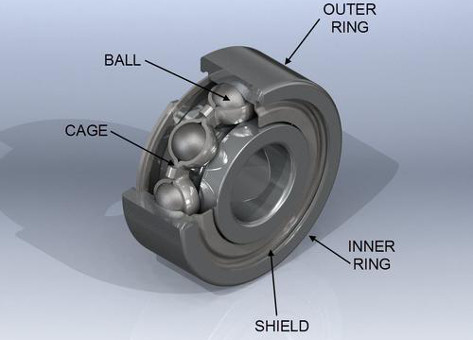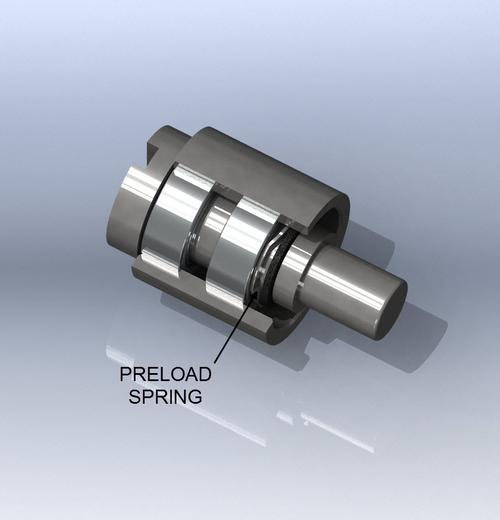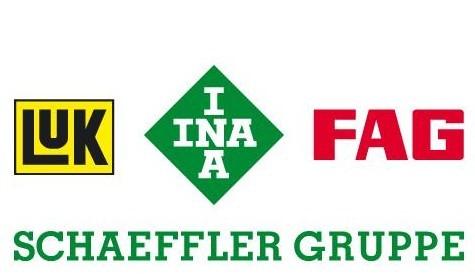Bearing Design Considerations in Medical Technology
It is estimated that there are more than 500,000 medical products on the market today. Many of these devices rely on rolling element bearings to achieve required performance levels. Engineers and designers are faced with unique challenges developing these products, and bearings play a key role in both simple and complex devices.
 Bearing materials
Bearing materials
All bearings should be manufactured using rings produced from high-purity material. For most medical applications, martensitic stainless steel, similar to AISI 440C, is recommended and often required due to regulatory requirements. This material, which can be specified differently depending on its manufacturer, provides for good corrosion resistance and has fine, evenly dispersed carbides, which result in lower noise and vibration levels than 440C. This type of stainless steel is very desirable, particularly in high-speed devices.
Nitrogen-enhanced martensitic stainless steel is also available, and while it is more expensive, it offers up to five times the corrosion resistance when compared to traditional 440C type materials. Other benefits of this material are very low noise levels, extended fatigue life due to its fine structure that contains smaller chromium nitrides (as opposed to chromium carbides), and a high resistance to corrosion resulting from exposure to blood.
In some cases, balls produced from ceramic materials, such as silicon nitride, can prove beneficial. Ceramic balls exhibit high hardness and are lightweight, highly polished, nonmagnetic, and resistant to attack from most liquids and chemicals. Ceramic balls greatly improve the high-speed capability of the bearing. Bearings made of steel rings and ceramic balls are commonly called hybrid bearings. While ceramic balls have an impressive list of beneficial characteristics for bearing applications, they are not a cure-all medicine. Due to the high hardness of the ball, contact stress is increased, so fatigue life is compromised. When the typical failure mode is characterized by fatigue, it’s usually best to stick with steel balls.
Retainers, or ball separators, are typically produced from a 300 series stainless steel. In high-speed applications, it is often necessary to use a plastic or phenolic resin snap-in or crown style retainer. For very high speeds, an angular contact bearing with a full-machined retainer is recommended. These types of retainers provide increased stability at higher speeds.
Phenolic resin cages have a porous structure and can be impregnated with oil for additional lubricity. Some of the plastic materials, such as polyamide-imides, contain additives such as graphite and Teflon for additional lubricity in emergency running conditions. A wide array of lightweight plastic materials are available that can handle temperatures up to 500F and are autoclavable.
An autoclave is a device used to sterilize surgical tools, dental drills, or other devices by subjecting them to high-pressure saturated steam for around 20 to 30 minutes depending on the size of the load. This is a common practice that can hurt the bearing materials and lubrication.
Lubrication
Lubricant selection may be the specification most overlooked by designers and engineers. Bearing life depends on proper lubrication in terms of both type and amount. In many cases, miniature and smaller instrument bearings are lubricated once for the lifetime of the device. Thousands of greases and oils are available that are designed to function in a variety of conditions and environments.
Operating temperature is the primary consideration when selecting a lubricant. Temperature directly impacts the base oil’s viscosity, which in turn impacts the ability to support loads. In the world of medical devices, bearing lubricants are subjected to sterilization, temperature extremes, high-speed rotation, saline washdown or irrigation, chemicals and reagents, blood, and radiation.
Lubricant selection not only depends on the operating conditions the bearing will face, but may also be subject to regulatory requirements. Manufacturers of medical devices are often required to use what are known as food-grade lubricants, which are broken into categories based on the likelihood they will contact food.
H1 lubricants are food-grade lubricants used in food processing environments where there is some possibility of incidental food contact. H2 lubricants are used on equipment and machine parts in locations where there is no possibility that the lubricant or lubricated surface will contact food. Finally, H3 lubricants, also known as soluble or edible oil, are used to clean and prevent rust on hooks, trolleys, and similar equipment.
Due to the wide array of products, prices, and availability, both a lubrication specialist and the bearing manufacturer should be consulted before making a final lubricant selection.
 Surgical and dental tools
Surgical and dental tools
Some of the more demanding medical applications include surgical and dental tools (drills and saws), laboratory and diagnostic equipment, and imaging equipment. Bearings of special design, or catalogue bearings with modifications or enhancements, are typically required. These handheld tools, particularly dental drills, generally operate at very high speeds — rotational speeds of 400,000RPM or higher are common. Low speed is 125,000RPM, which is quite fast. High-precision (ABEC 5 and 7) miniature and instrument series ball bearings are used.
However, for ultra-high speeds, these bearings are modified further and have improved raceway surface finishes. In addition, the raceways and surfaces that guide the retainer have tighter dimensional and geometrical tolerances, in some cases ABEC 9. More expensive angular contact designs are often recommended for their high-speed stability, and they also allow for the use of full machined type retainers. This, again, enhances speed capability.
Running at high speeds also presents challenges with instrument noise levels and heat generation. High audible noise during a dental procedure is a problem for both the dentist and the patient. When bearings are assembled, it is necessary to have a certain amount of internal clearance, or radial play, built in. This allows for one bearing race to move both radially and axially relative to the other.
Application of a preload across a pair of bearings is recommended. Preload can be defined as the application of an axial load across a pair of bearings to force the rolling elements to assume a contact angle for the purpose of removing the internal clearance. The result is constant ball-to-race contact. This reduces ball skidding, vibration, and noise. However, disadvantages of preload include torque, heat, and reduction in fatigue life. Preload determination is a balancing act where the goal is to apply the least amount of axial preload force possible while meeting the performance requirements of the instrument.
During surgery, the bearings in tools are regularly exposed to harsh conditions and liquids, including blood and saline, as well as particulate debris. When space permits, shielded bearings should always be used. The speed of these tools is generally too high for seals, but when conditions permit, seals should be used. Seals are the best option for keeping foreign debris out of the interior of the bearing and keeping lubricant in.
Laboratory and diagnostic equipment
The laboratory work that goes into the testing of blood, urine, tissue, and other specimens is critical for the timely diagnosis and treatment of millions of patients every day. Thousands of tests are prescribed in hematology, immunochemistry, and histology every hour in hospitals and laboratories around the world.
In the area of hematology, samples are typically subjected to a variety of conditions during testing and analysis. This includes light scatter analysis techniques for counting cells, mechanical motion and agitation, controlled temperature and humidity cycles, and the addition of reagents. Medical technologists use advanced laboratory and diagnostic equipment to conduct and catalogue these tests and results.
Due to the high volume of tests and the requirements for reliability, these test systems are often highly automated and programmable and have full data management and storage capabilities. In addition, they can handle hundreds of samples (oftentimes open vials) and conduct multiple tests during an automated cycle. These systems have demanding positioning requirements and utilize a variety of different types of bearings, including linear, angular contact, thin section, and miniature and instrument ball bearings.
Bearings for these applications should be manufactured from the type of martensitic stainless steels described previously. The bearings are often exposed to high humidity or moisture resulting from condensation. In addition, they are exposed to fluids during testing that include blood and the reagents used for the test, so good fatigue life is critical.
Sealed bearings should be considered whenever the potential for contamination exists. The most common bearing seal material is a nitrile rubber. However, this may not be well suited or permitted, due to regulatory requirements. Teflon seals are often used in medical devices. They have outstanding chemical resistance and high- and low-temperature capability, and they exhibit less torque than nitrile rubber seals. Viton is also available when a more robust seal is required. The seals found on most types of bearings are not designed for immersion, and fluid penetration will eventually take place. They offer excellent protection from particulate contaminants or a fluid splash and wipedown situation.
These systems move test samples (most often vials) to various locations within the machine for scanning, testing, or the addition of a reagent prior to analysis. In addition, samples may be spun, shaken, or otherwise agitated for various reasons. These movements and motions are then repeated over thousands of cycles. To achieve the precise positioning and repeatability requirements, in most cases, bearings should be ABEC 3 or better. Housing and shaft design should allow for very precise fitting to minimize any eccentricities or the chance for slippage or fretting. When fitting bearings that have thin cross sections, such as miniature bearings, line-to-line fits are commonly specified. Interference fits can reduce the internal clearance in the bearings. If this reduction is excessive, bearing life will be compromised.
In these applications, where positional accuracy must be controlled to precise levels, radial (and axial) play in the bearing is usually unacceptable. Application of a preload, described previously, is recommended. The principal benefits are precise shaft positioning (no free motion), control of axial and radial compliance, and shared loading between bearings. In addition, shaft rotational accuracy is greatly improved, minimizing runout characteristics.
Pharmaceutical, dental, and medical device applications present many challenges for bearings. These include high speeds, low noise, long service life, and resistance to harsh environments or aggressive chemicals or fluids. Bearing manufacturers conduct continuous research into materials for components such as retainers, special lubricants, and optimization of the bearing geometry to in order to meet the ever-increasing demands of the industry. In addition to superb product quality, bearing suppliers must offer a flexible approach to problem solving.
Source:bearing-news
【 Go Back 】 | 【 Print 】 | 【 Close this window 】









